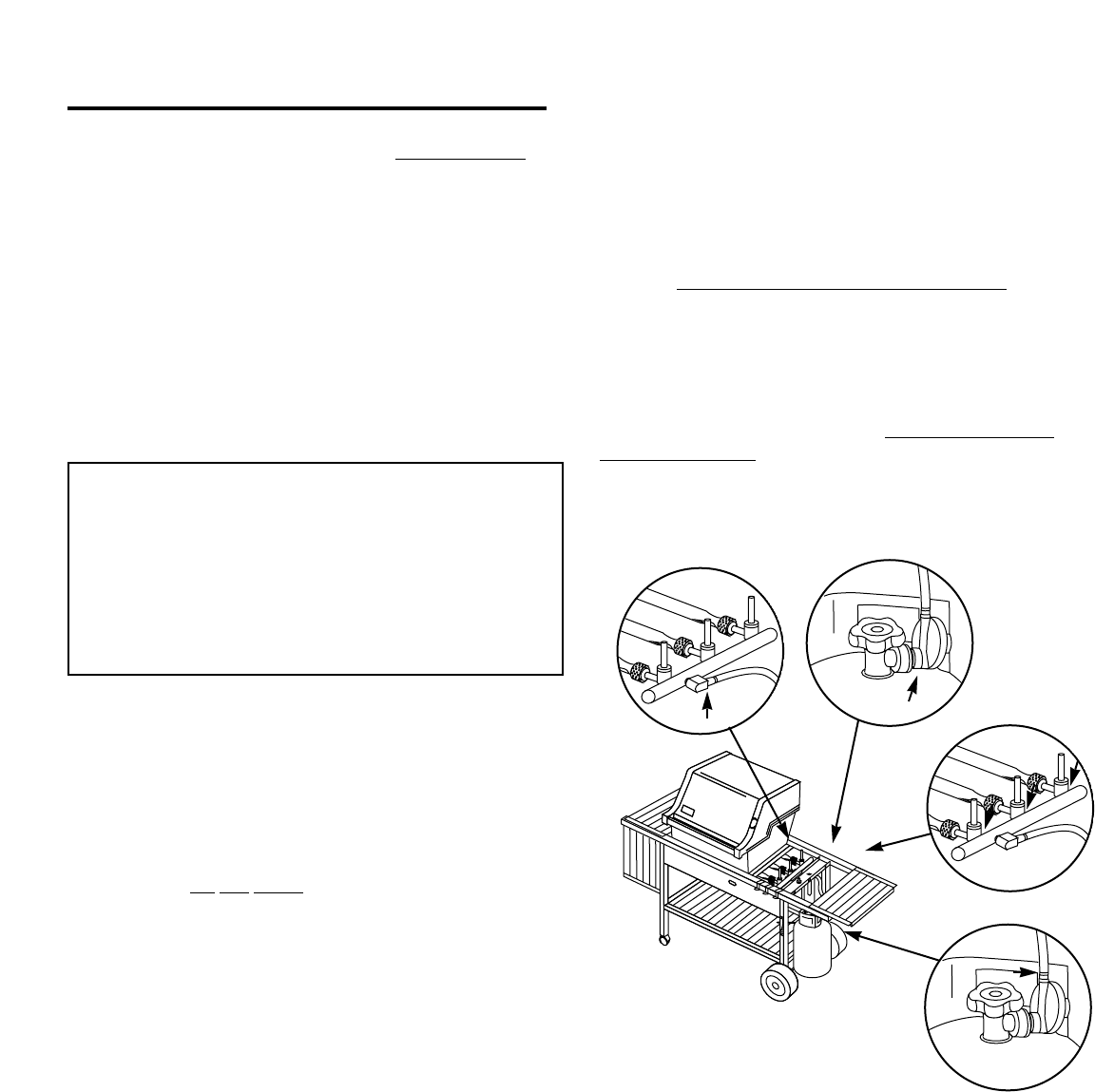User Manual
Table Of Contents
- DANGER
- WARNINGS
- WARRANTY
- LP Tank
- PATENTS AND TRADEMARKS
- Contents
- FEATURES
- General Instructions
- For Installation in Canada
- Storage
- Operating area
- Assembly
- Tools needed
- Supplies needed
- Check package contents
- Assemble wheels
- Assemble frame
- Continue frame assembly
- Complete frame assembly
- Insert casters
- Add cooking box
- Install manifold bracket
- Install tank panel assembly
- Add fuel scale assembly
- Install igniter
- Set LP fuel scale
- Fill LP tank
- Check that the burner valves are off
- Connect LP tank
- Check for gas leaks
- Install Flavorizer Bars and Cooking Grates
- Install the bottom tray
- Install the lid
- Install tool holders, control panel and burner control knobs
- Install swing table
- Complete accessory installation
- OPERATING INSTRUCTIONS
- Lighting
- Crossover Ignition System
- To Extinguish
- Manual Lighting
- To Extinguish
- Cooking
- Storage and/or Nonuse
- Periodic Cleaning
- Refilling the LP tank
- Removal of the LP tank
- Connecting the filled LP tank
- LP Tank
- Safe handling tips for LP Gas
- Liquid Propane (LP) Tank(s)
- Annual Maintenance
- Inspection and Cleaning of the Weber Spider Stopper Guards
- General Maintenance
- Weber Spider Stopper Guards
- Main Burner Flame Pattern
- Main Burner Cleaning Procedure
- Replacing Main Burners
- Crossover Ignition System Operations
- TROUBLESHOOTING
- Parts List
- A FINAL WORD OF THANKS

28
Figure 8
(a) (b)
(c)
(d)
Annual Maintenance
After a period of nonuse we recommend that you perform
the following maintenance procedures for your safety.
WARNING: Check hose before each use of barbecue
for nicks, cracking, abrasions or cuts. If the hose is
found to be damaged in any way, do not use the
barbecue. Replace using only Weber authorized
replacement manifold assembly. Order from Weber-
Stephen Products Co., Customer Service Center or
authorized dealer.
■ Inspect the burners for correct flame pattern. Clean if
necessary, following the procedures outlined in the
"General Maintenance" section of this manual.
■ Check all gas fittings for leaks.
DANGER
Do not use an open flame to check for gas
leaks. Be sure there are no sparks or open
flames in the area while you check for
leaks. This will result in a fire or explosion
which can cause serious bodily injury or
death, and damage to property.
WARNING: You should check for gas leaks every
time you disconnect and reconnect a gas fitting.
You will need: a soap and water solution and a rag or
brush to apply it.
Make sure main burners are in the OFF position.
To perform leak checks: Turn on gas supply.
WARNING: Do not ignite burners while leak checking.
Check for leaks by wetting the connections with the soap
and water solution and watching for bubbles. If bubbles
form or if a bubble grows there is a leak.
Note - Since some leak test solutions, including soap and
water, may be slightly corrosive, all connections should be
rinsed with water after checking for leaks.
Check:
a) Hose to manifold connections. Figure 8 (a).
b) Regulator to tank connection. Figure 8 (b).
WARNING: If there is a leak at connection (a),
retighten the fitting with a wrench and recheck for
leaks with soap and water solution.
If a leak persists after retightening the fitting, turn OFF
the gas. DO NOT OPERATE THE BARBECUE. Contact
Weber-Stephen Customer Service.
c) Valves to manifold connection. Figure 8 (c).
d) Hose to regulator connection. Figure 8 (d).
WARNING: If there is a leak at connections
(b), (c) or (d), turn OFF the gas. DO NOT OPERATE
THE BARBECUE. Contact Weber-Stephen Customer
Service.
When leak checks are complete, turn gas supply OFF at
the source and rinse connections with water.
Inspection and Cleaning of the Weber Spider
Stopper Guards
To inspect the Spider Stopper Guards, remove the control
panel and look to see if they have dust or dirt on their
outside surfaces. If they do, brush off the outside surface of
the Spider Stopper Guards with a soft bristle brush (an old
toothbrush for example). Check that there are no gaps in
the Spider Stopper Guards’ seams or in the fit around the
burners or valves. (See Section "General Maintenance".)










